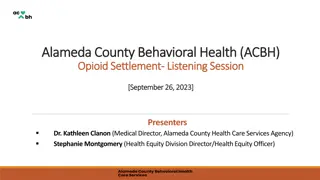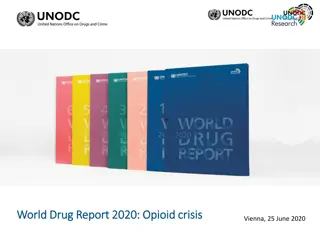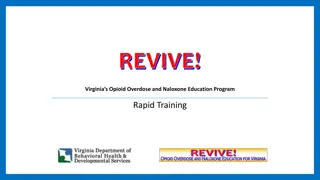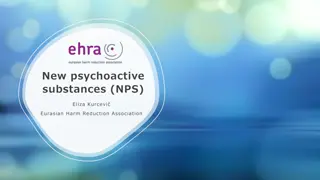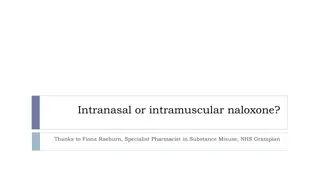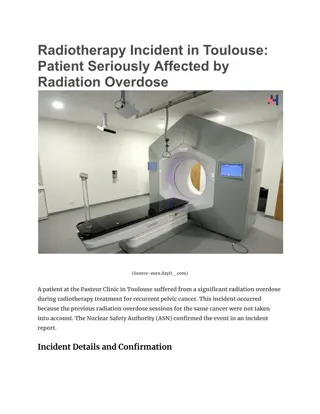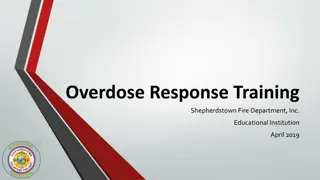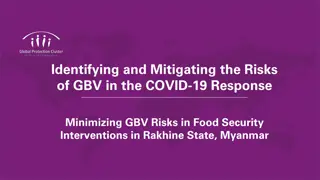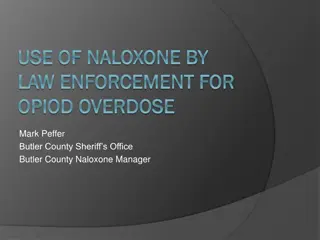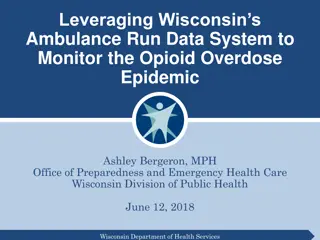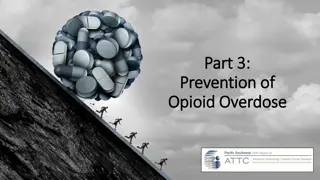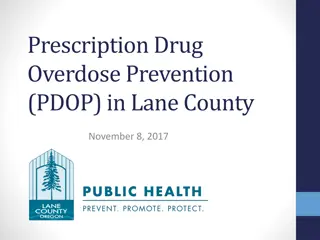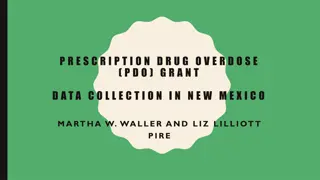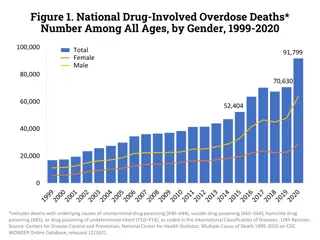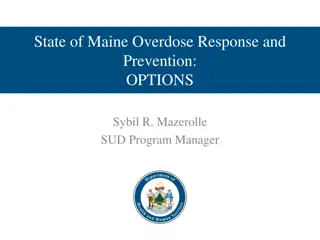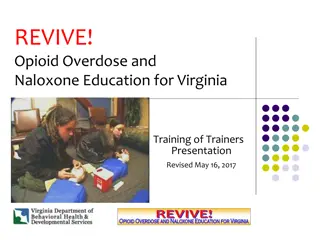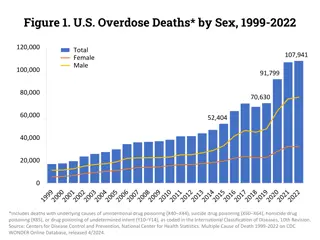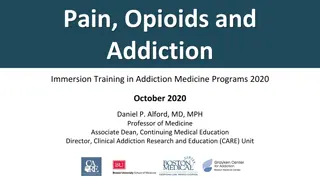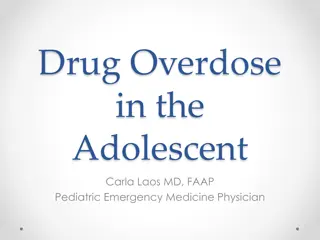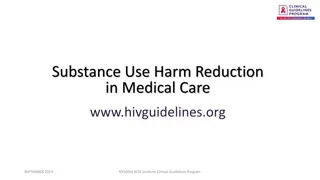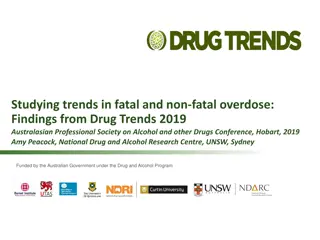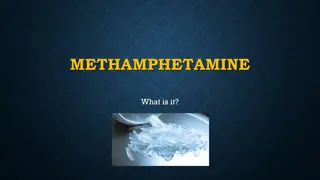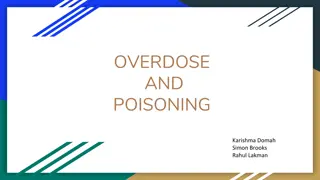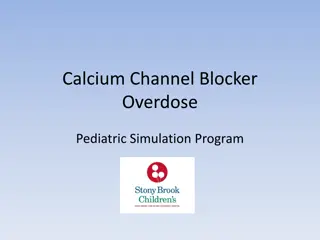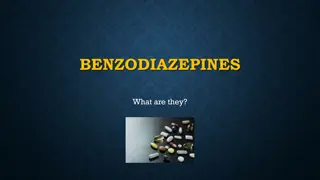The Power of Collaboration in Harm Reduction and Public Safety Partnerships
Learn about successful collaborations in harm reduction and public safety to prevent overdose, featuring insights from various presenters and an overview of pilot projects supported by the National Council and CDC. The webinar emphasizes evidence-based strategies, integration of harm reduction and p
1 views • 31 slides
Opioid Use Disorder Treatment Guidelines 2024
The February 2024 NYSDOH AIDS Institute Clinical Guidelines Program focuses on assisting clinicians in engaging with patients about opioid use disorder (OUD) treatment goals, emphasizing overdose prevention, providing updated information on available treatment options, and offering recommendations f
2 views • 24 slides
Managing Power Platform Risk with an Environment Strategy by Frank Shink, Senior Power Platform Design Engineer at Ameriprise Financial
Frank Shink, a seasoned professional, delves into the risks associated with Power Platform, from development risks to cost risks, and offers insights on tools and strategies to combat these risks effectively. He emphasizes the importance of environments, DLP policies, and licensing strategies in mit
1 views • 20 slides
Alameda County Behavioral Health Opioid Settlement Listening Session
Alameda County Behavioral Health (ACBH) conducted a listening session on September 26, 2023, addressing the opioid crisis, definitions of opioids, medication-assisted treatments, and current data on overdose deaths in the county. The session highlighted the rapid increase in opioid-related overdose
1 views • 31 slides
2018 Mortality Statistics: Life Expectancy, Drug Overdose, Maternal Mortality Released
Mortality statistics for 2018 were released on January 30, 2020, highlighting life expectancy trends, drug overdose statistics, and the first maternal mortality rate in over a decade. A comprehensive communications strategy was executed to disseminate the data, including a new website, visual abstra
0 views • 9 slides
Overview of Opioid Crisis in North America and Africa
The opioid crisis in North America and Africa presents common threats and differing dynamics. Factors such as ease of manufacturing, interchangeability of fentanyl and tramadol, and market dynamics contribute to the crisis. In North America, high rates of prescription opioids have led to diversion a
1 views • 26 slides
Understanding Opioid Overdose and Naloxone Education Program in Virginia
The Virginia Opioid Overdose and Naloxone Education Program provide rapid training on opioids, overdose risks, naloxone usage, and emergency response protocols. Opioids include various drugs with potential overdose risk factors such as prior overdoses, reduced tolerance, mixing drugs, and certain me
0 views • 8 slides
Understanding New Psychoactive Substances (NPS) and Their Categories
New Psychoactive Substances (NPS) are substances of abuse not regulated by international drug conventions, posing significant public health risks. These substances can fall under categories like synthetic cannabinoids, stimulants, hallucinogens, and depressants, each with unique risks and effects. S
0 views • 11 slides
Nasal vs Intramuscular Naloxone: A Comparison for Opioid Overdose Response
When administering naloxone for opioid overdose, choosing between nasal spray and intramuscular injection involves considerations such as ease of use, effectiveness in various conditions, and duration of action. Both methods have their advantages and may depend on individual circumstances. Nasal nal
0 views • 11 slides
Patient Seriously Affected by Radiation Overdose
A patient at the Pasteur Clinic in Toulouse suffered from a significant radiation overdose during radiotherapy treatment for recurrent pelvic cancer.
0 views • 3 slides
Understanding Opioid Overdose Response Training
Learn about opioids, recognizing opioid overdose, and responding to emergencies in this educational training by Shepherdstown Fire Department. Get insights on opioid receptors, hierarchy of opioids, chemical anatomy, and factors putting individuals at risk. Equip yourself with the knowledge to admin
0 views • 29 slides
Identifying and Mitigating GBV Risks in COVID-19 Response for Food Security in Rakhine State, Myanmar
Rakhine State faces challenges of conflict, displacement, and restricted movement, with many relying on food assistance. Cash assistance implementation did not escalate GBV risks. The COVID-19 restrictions heightened the need for adjustments in programming, requiring monitoring of assistance changes
0 views • 5 slides
Understanding Artificial Intelligence Risks in Short and Long Term
This content delves into the risks associated with artificial intelligence, categorizing them into short-term accident risks and long-term accident risks. Short-term risks include issues like robustness problems and interruptibility, while long-term risks focus on competence and alignment challenges
0 views • 15 slides
Naloxone Use by Law Enforcement for Opioid Overdose: Importance and Benefits
Naloxone is a critical medication used by law enforcement to reverse opioid overdoses. The Davids Law-Opioid Overdose Reversal Act allows first responders to possess and administer Naloxone. The Good Samaritan Provision provides immunity to those calling for help during an overdose. Naloxone works b
0 views • 36 slides
Risks and Health Impact of Edible Cannabis Consumption in Young People
Edible cannabis products, such as sweets and drinks, pose serious risks to young individuals due to their resemblance to regular sweets, delayed onset of effects, and potential for overdose. Consumption of these products can result in health issues like increased heart rate, cognitive impairment, ps
0 views • 10 slides
Monitoring Wisconsin's Opioid Overdose Epidemic Through Ambulance Data
Utilizing Wisconsin's Ambulance Run Data System (WARDS), this initiative aims to enhance opioid overdose surveillance by analyzing nonfatal overdose data in real-time. By developing specific case definitions and identifying key variables of interest, the project seeks to improve the timeliness of mo
0 views • 25 slides
Understanding Fentanyl: Risks and Identification
Fentanyl, a potent synthetic opioid, poses significant risks due to its strength and widespread illicit manufacturing. Learn about the types of fentanyl, how to identify illicitly manufactured forms, why it is a major concern for public health, and signs of overdose. Stay informed to protect yoursel
0 views • 10 slides
Understanding Opioid Overdose and Prevention Methods
The World Health Organization defines opioid overdose as a condition that can lead to respiratory depression and death, often identified by pinpoint pupils, unconsciousness, and respiratory depression. The statistics show a concerning rise in opioid-related deaths, emphasizing the urgent need for pr
0 views • 13 slides
Comprehensive Overview of Prescription Drug Overdose Prevention Efforts in Lane County
Efforts in Lane County to prevent prescription drug overdose include forming alliances, organizing educational sessions for prescribers, promoting Naloxone access, and engaging with the community and law enforcement. Initiatives also involve monitoring and addressing risky prescribing practices and
0 views • 13 slides
Training and Data Collection Tools for Prescription Drug Overdose Grant in New Mexico
This information provides insights into a Prescription Drug Overdose grant program in New Mexico, focusing on training and distributing Naloxone to combat opioid overdose. The program involves a hub and spoke system, where entities like county organizations and local agencies play crucial roles in t
0 views • 22 slides
Trends in National Drug-Involved Overdose Deaths from 1999-2020
The figures depict the alarming rise in drug-involved overdose deaths in the United States over the period 1999-2020. Figure 1 shows the number of deaths by gender, Figure 2 highlights specific drug categories involved, Figure 3 focuses on opioid-related deaths categorized by gender, and Figure 4 de
0 views • 10 slides
Maine Overdose Response and Prevention Program Overview
The State of Maine's Overdose Response and Prevention Program aims to combat substance use disorders through community-based initiatives, public messaging campaigns, and harm reduction strategies. The program includes elements such as community recovery partners, embedded SUD clinicians in first res
0 views • 11 slides
Understanding REVIVE! Opioid Overdose and Naloxone Education Training
This presentation covers the REVIVE! training program in Virginia, focusing on opioid overdose response, naloxone education, legislation surrounding safe reporting of overdoses, and the goals of training lay rescuers in recognizing and reversing opioid overdoses.
0 views • 48 slides
Insights on the Opioid Crisis: Analyzing CDC Data and Policy Recommendations
Delve into the complexities of the opioid crisis through an examination of CDC data depicting the relationship between opioid addiction and overdose deaths. Contrary to popular belief, the crisis is not solely attributed to physicians over-prescribing opioids. Gain a deeper understanding of who is p
0 views • 10 slides
Job Corps Physician Monthly Teleconference and Opioid Overdose Response Guidelines
Job Corps conducts a monthly teleconference for physicians across different regions. Zero new cases of COVID-19 among Job Corps students were reported. Guidelines for responding to opioid overdose in Job Corps include the availability of Narcan kits in various locations and staff training on recogni
0 views • 27 slides
Addressing Climate Change Risks: Guidance for Senior Managers and Board Members
This slide pack tool provides guidance on addressing climate change risks for senior managers and board members. It covers key messages such as understanding obligations and gaps, identifying climate change risks, exploring responsibilities, and implementing actions to address these risks effectivel
0 views • 11 slides
Understanding Opioid Epidemic Impact & Harm Reduction in Michigan
The Michigan Emergency Department Improvement Collaborative (MEDIC) works to improve emergency care quality, with a focus on opioid overdose. Over 3,000 Michiganders died from opioid overdose in 2021, exceeding motor vehicle-related deaths. Harm reduction strategies, like distributing naloxone in ED
0 views • 10 slides
Understanding the Risks of Cheap Natural Gas and Hydraulic Fracking
This introduction delves into the multifaceted risks associated with the exploitation of cheap natural gas and hydraulic fracking. Covering climate risks, economic consequences of petro-states, direct GHG risks, and local environmental risks, the content underscores the complex challenges and implic
0 views • 8 slides
Delays in Seeking Help Following Accidental Overdose: Understanding Witnesses' Perspectives
Exploring the reasons behind witnesses delaying help-seeking after an accidental overdose, this study by Katie Hail-Jares delves into incarceration, loss of tolerance, social support systems, and witness behavior. It highlights the challenges of witness reporting in substance use settings and the im
0 views • 19 slides
Opioid Overdose Deaths in the U.S.: Trends and Analysis
The figures illustrate the concerning rise in opioid overdose deaths in the United States from 1999 to 2022. Graphs depict overdose deaths by sex, specific drugs or drug categories, involvement of opioids, and prescription opioids. The data highlights the impact of opioids on both genders and the ro
0 views • 10 slides
Understanding Chronic Pain, Opioids, and Addiction in Medicine
Chronic pain is a complex issue that can impact individuals on various levels. It is important to understand the subjective nature of pain and the barriers to adequate pain care. Opioid analgesics, while effective in managing pain, come with risks such as side effects, addiction, and overdose potent
0 views • 28 slides
Understanding Adolescent Drug Overdose and Suicide Risks
This presentation dives into the concerning epidemiology of adolescent drug overdose and suicide, discussing various ingestions such as Skittles parties, marijuana, alcohol, and OTC medications. It sheds light on the role of social media in adolescent substance abuse and highlights risk factors, inc
0 views • 42 slides
Substance Use Harm Reduction in Medical Care Guidelines
This guideline aims to promote practical harm reduction strategies to mitigate negative consequences linked with substance use. It emphasizes healthcare clinicians to provide medical care, including screening for HIV and HCV, for patients using substances. It also suggests offering harm reduction co
0 views • 15 slides
Trends in Fatal and Non-Fatal Overdose: Drug Trends 2019 Conference Findings
Studying trends in fatal and non-fatal overdose at the Australasian Professional Society on Alcohol and other Drugs Conference in 2019, Amy Peacock presented findings funded by the Australian Government. The research involved analyzing data sources like cryptomarket data, mortality data, hospitaliza
0 views • 13 slides
Impact of Opioid Crisis on Men in Trades: Addressing Work Culture and Health Risks
The opioid overdose crisis has significantly affected men in trades, leading to a high number of opioid-related deaths and hospitalizations. This issue is exacerbated by factors such as over-reliance on pain medication, illicit drug use, and the high physical demands of their work. Men in trades oft
0 views • 28 slides
Understanding Methamphetamine: Effects, Risks, and Harm Reduction
Methamphetamine, also known as meth, crystal meth, or ice, is a potent central nervous system stimulant with short-term effects like euphoria and rapid breathing and long-term risks such as tooth decay and psychosis. This drug is addictive and carries various health hazards, including overdose and H
0 views • 8 slides
Comprehensive Guide to Overdose and Poisoning Management
Poisoning and overdose are common occurrences with serious implications. They encompass various toxidromes and require a systematic approach covering risk assessment, resuscitation, investigations, supportive care, decontamination, antidotes, and disposition planning. Recognizing signs of poisoning
0 views • 25 slides
Understanding GHB, GBL, and 1,4 BD: Types, Effects, and Risks
GHB and GBL, known as G drugs, are controlled substances impacting brain receptors similar to alcohol. They induce varying effects such as euphoria, relaxation, and sedation. Overdosing on these drugs can be life-threatening due to their fine margin between desired effects and toxicity. Combining G
0 views • 12 slides
Calcium Channel Blocker Overdose in Pediatrics
Calcium channel blocker overdose is a critical condition that can be life-threatening, especially in children. The overdose can result in symptoms such as syncope, chest pain, weakness, and seizures due to the medication's effects on cardiovascular function. Prompt recognition and appropriate manage
0 views • 14 slides
Understanding Benzodiazepines: Uses, Effects, and Risks
Benzodiazepines, also known as benzos, are prescription drugs commonly used to treat insomnia, anxiety, and muscle spasms. They offer short-term relief but can lead to addiction and dangerous side effects. From sedation to memory loss, dependency, and overdose risks, this article covers the various
1 views • 10 slides



